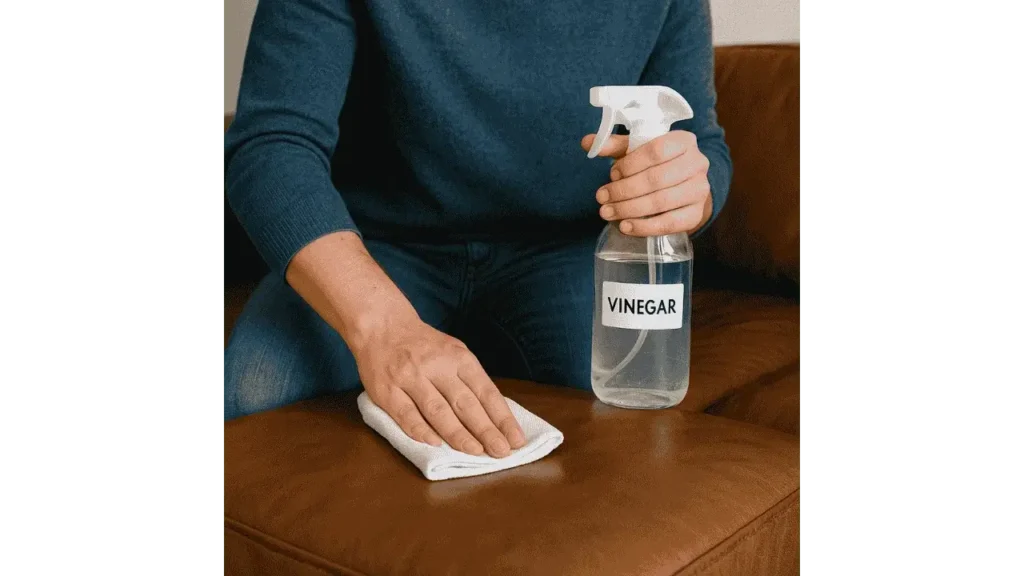Cleaning a leather couch doesn’t have to involve fancy products or expensive kits. With the right care, something as simple as white vinegar can do the job without harming the leather. When used properly, vinegar helps remove dirt and buildup while still preserving the material’s natural feel. This guide shows exactly how to do it right, without shortcuts or risk to your furniture.

Why Does Vinegar Work on Leather?
White vinegar, when diluted, is a practical tool for everyday leather care. It’s not just about cleaning; it also helps neutralize odor and remove surface grime gently. Because leather is porous and sensitive, it’s important to avoid anything too strong or chemical-heavy.
“Vinegar is safe when watered down and used sparingly,” says Julie Peters, a furniture restorer with over a decade of experience. “It’s especially helpful when regular wipes aren’t cutting through body oils or buildup.”
How to Clean a Leather Couch with Vinegar?
Mix a Gentle Cleaning Solution
Start by mixing equal parts white vinegar and distilled water. This creates a balanced solution that’s strong enough to clean but mild enough for leather. Stir well and pour into a clean spray bottle or bowl. Never use vinegar straight; it will dry out the leather over time.
Test Before You Commit
Always test your cleaning solution on a small hidden area first. Dampen a soft cloth with the mix and gently wipe a corner behind a cushion. Let it dry fully. If there’s no change in color or texture, the solution is safe to use.
Clean with Gentle Motions
Dampen a microfiber cloth with the diluted vinegar. Wipe the surface in smooth, circular motions, one section at a time. Focus on armrests, headrests, or any areas that show visible dirt. Avoid saturating the leather; keep the cloth damp, not wet.
Learn More: Styling a Brown Leather Couch
Dry It Down Immediately
Take a dry microfiber cloth and go over the cleaned areas right after wiping. This helps remove any lingering moisture. Let the couch finish drying on its own away from direct sunlight or heaters, both of which can damage the leather.
Condition the Leather After Cleaning
Once the couch is completely dry, apply a leather conditioner. Use a small amount and work it into the surface with a clean cloth. This step is not optional. It helps replace the oils that can be lost during cleaning and keeps the leather soft and flexible. “Conditioning after any type of cleaning is what keeps leather from cracking over time,” says Brandon Knox, owner of a specialty leather repair shop in Toronto.
Mistakes That Can Damage Leather
Skip the shortcuts. Never use pure vinegar. Don’t soak the surface or leave the couch drying under heat. Scrubbing too hard can scratch the finish. Gentle hands, proper dilution, and a slow pace work far better than pressure or speed.
When and How Often to Use Vinegar?
Use a vinegar-based cleaner once a month or only when the couch actually needs a deeper refresh. For day-to-day upkeep, a dry cloth is enough to remove dust. Overcleaning can strip the natural oils and weaken the surface, so less is usually more when it comes to leather care.
Final Takeaways
White vinegar, when diluted and used correctly, is a dependable way to clean your leather couch. It removes dirt without harsh side effects, keeps odors down, and prepares the surface for conditioning. With steady hands and the right aftercare, your couch will stay clean, soft, and long-lasting; without the need for expensive products.
- How to Wear an Oversized Leather Jacket? Style Tips for a Casual Look - August 6, 2025
- How to Fold a Leather Jacket? - August 5, 2025
- How Should a Leather Jacket Fit a Woman? - August 1, 2025



